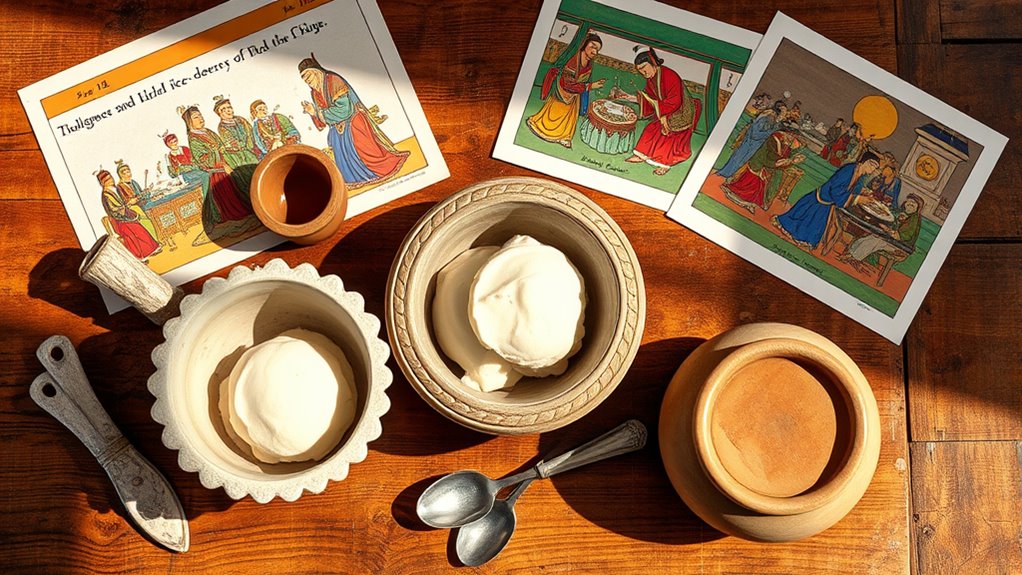The origins of ice cream trace back to ancient China and Persia, where people used ice, snow, salt, honey, and fruits to make frozen treats centuries ago. In China around 200 BC, milk and rice were frozen combined with salt and ice, while Persians flavored snow with honey and spices, creating luxurious desserts. These early innovations laid the groundwork for modern ice cream. Keep exploring to see how these ancient methods evolved into the popular treat we enjoy today.
Key Takeaways
- Early ice cream-like desserts originated in ancient China (200 BC) with rice, milk, salt, and ice, focusing on sweet, dairy-based flavors.
- Persian civilizations (7th century AD) created luxurious frozen treats using snow, honey, fruits, and aromatic spices.
- Cooling techniques with salt and ice, developed over time, enabled longer-lasting frozen desserts across cultures.
- Ancient civilizations like Rome and Byzantium experimented with snow or crushed ice mixed with fruits to create early frozen confections.
- These historical innovations laid the foundation for modern ice cream, blending regional ingredients and cultural influences.

Ice cream has a long and fascinating history that dates back thousands of years, with roots stretching across many ancient civilizations. As you explore its origins, you’ll find that early versions of frozen treats were crafted using simple ingredients and inventive methods. Historical recipes from ancient China, Persia, and beyond reveal that people have long sought ways to enjoy chilled desserts. In China, around 200 BC, a mixture of milk and rice was frozen using salt and ice, creating a primitive form of ice cream. These early recipes often involved combining dairy with fruits or sweeteners, showcasing the ingenuity of ancient cooks. Similarly, Persia contributed its own innovations, with historical recipes dating back to the 7th century AD. Persians used a mixture of snow or crushed ice, flavored with honey, fruits, and aromatic spices, to create a luxurious frozen treat. Their approach was sophisticated, often involving specialized containers and methods to keep the dessert cold longer, emphasizing the importance of cooling techniques in historical recipes. The development of cooling methods played a crucial role in expanding the variety and quality of early frozen desserts.
As ice cream spread across different regions, it adapted to local tastes and ingredients, which is where cultural variations come into play. In ancient China, the focus was on rice-based flavors and sweetened dairy, reflecting local agricultural products and culinary preferences. Persian recipes, on the other hand, leaned heavily on honey and exotic spices, creating a rich, aromatic experience that signaled wealth and sophistication. Moving westward, the Romans and Byzantines also experimented with frozen desserts, often combining fruit purees with snow. These variations highlight how each civilization infused their cultural influences into the basic idea of a cooled, sweet dish.
The evolution of ice cream continued through the centuries, but understanding its early history helps you appreciate how diverse and inventive ancient recipes were. The core concept of freezing a mixture of dairy, fruit, and sweeteners persisted, but each culture added its own twist, resulting in a variety of unique flavors and textures. Today’s ice cream owes much to these ancient innovations, and recognizing the cultural variations in historical recipes offers insight into how a simple idea became a global phenomenon. From the salt-and-ice methods of China to the honeyed, spiced desserts of Persia, the journey of ice cream reflects a rich tapestry of human creativity and cultural exchange.
Frequently Asked Questions
What Ingredients Were Used in Ancient Ice Cream Recipes?
In ancient ice cream recipes, you’d find ingredients like milk and water mixed with traditional sweeteners like honey or fruit syrups. They often added ancient flavorings such as spices, herbs, or fruit purees to enhance taste. Sometimes, salt was used to lower the temperature. You’d churn these ingredients to create a cold, invigorating treat, blending natural flavors with simple, traditional ingredients to produce the earliest versions of ice cream.
How Did Ice Cream Spread Across Different Civilizations?
You might find it fascinating that by the 17th century, ice cream had reached Europe through trade routes connecting Asia, the Middle East, and Africa. These routes facilitated cultural influences and the exchange of ingredients, helping spread the treat worldwide. As you explore further, you’ll see how trade and cultural interactions played a vital role in evolving ice cream from a luxury to a popular dessert across civilizations.
What Were the Earliest Methods of Preserving Ice Cream?
You discover that the earliest methods of preserving ice cream involved cold storage techniques and ice cream fermentation. People used natural ice and snow to keep it cold, sometimes mixing it with salt to lower the temperature further. These techniques allowed them to prolong freshness and enjoy ice cream longer. Over time, innovations like ice cellars and early refrigeration improved preservation, making ice cream more accessible and enjoyable across civilizations.
When Did Ice Cream Become Popular in Europe and America?
You won’t believe how quickly ice cream took Europe and America by storm! By the 18th century, European indulgence made it a royal favorite, and American innovations turned it into a household obsession. Sophisticated recipes and new freezing techniques skyrocketed its popularity, making ice cream accessible to everyone. Today, it’s a global sensation, but it all started with those early European indulgences and bold American innovations that transformed frozen treats into a cultural staple.
How Have Modern Technologies Changed Ice Cream Production?
Modern technologies have revolutionized frozen desserts, making ice cream production faster and more efficient. You’ll notice that technological innovations, like automated mixing and advanced freezing methods, guarantee consistent quality and diverse flavors. These innovations reduce costs and spoilage, allowing you to enjoy a wider variety of ice cream anytime. With these advancements, you get smoother textures, better taste, and more creative options, transforming the way you experience frozen desserts every day.
Conclusion
As you’ve discovered, ice cream’s journey from ancient China and Persia to your modern scoop is truly fascinating. It’s a gentle reminder that some delights are worth the wait and the quiet innovations behind the scenes. So next time you enjoy your favorite frozen treat, remember the rich history quietly blending tradition and creativity. Embrace the subtle magic in every bite, knowing you’re part of a timeless story that continues to sweeten our lives in ways words can’t fully capture.










